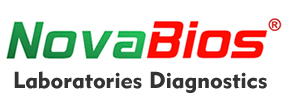
Login to find custom information.
Intended Use
The Novabios® Norovirus Test is a lateral flow immunoassay for the qualitative detection of norovirus antigens in stool. The assay uses Genogroup 1 and Genogroup 2 specific monoclonal antibodies precoated on the test membrane.
Introduction and Clinical Significances
Noroviruses (NoV) are a genetically diverse group of single stranded RNA, non-enveloped viruses belonging to the Caliciviridae family. For decades they were called “small round-structured viruses” (SRSV) or “Norwalk-like viruses” until recently when their taxonomy was investigated using modern molecular techniques. Initially four antigenic types of SRSV were determined but more recently three genogroups of Norovirus have been identified. Genogroup 1 and Genogroup 2 are associated with human infections whilst Genogroup 3 is associated with bovine and porcine infection. Noroviruses are a major cause of acute gastroenteritis worldwide, often causing explosive outbreaks in institutions. They are highly contagious with an inoculum of as few as ten particles that are able to cause infection. Transmission occurs through ingesting contaminated food and water and through person-to-person spread. Transmission is predominantly faecal-oral but may be airborne due to aerosolisation of vomitus which typically contains abundant infectious viral particles. Outbreaks may involve several routes of transmission. The disease is acute, usually mild, though it can cause fatalities among the elderly. It is self-limiting with an incubation period of 24-48 hours. In some cases infection with norovirus can occur within 12 hours of exposure. The ability of Noroviruses to cause outbreaks in institutions has become a major public health issue. Outbreaks of norovirus infection are associated with restaurants and institutions such as nursing homes, hospitals and elite sports camps. Infections in infants, elderly or frail patients can be fatal if left untreated. The symptoms of norovirus disease usually include nausea, vomiting, diarrhea and stomach cramps. Sometimes people have a low-grade fever, chills, headache, muscle aches and a general sense of tiredness. The disease often begins suddenly and the infected person may feel very sick. In general, children experience more vomiting than adults.
Principle of the Test
During testing, the stool specimen reacts with the conjugate antibodies against noroviuses. The mixture migrates chromatographically along the membrane by capillary action to react with antibodies against genogroup I and genogroup II noroviruses precoated on the membrane and generates colored lines in the test line region T1 and T2 respectively. The presence of colored lines in the test line regions T1 or T2 indicates a positive result, while their absence indicates a negative result. To serve as a procedural control a colored line will always appear in the control line region (C) indicating that proper volume of specimen has been added and membrane wicking has occurred.
Reagents and Materials Supplied
· 25 tests cassettes (individually packed in foil pouches)
· 25 sampling tubes with extraction solution (1 ml)
· 1 package insert
Additional Required Materials
Micropipette
Timer
Centrifuge
Storage & Stability
The Novabios ® Norovirus test should be stored between 2-30°C. The test is sensitive to humidity and to heat. It is stable until expiration date printed on the foil pouch. Test cassettes should be kept in foil pouches until use. Do not freeze.
Warnings and Precautions
For in vitro diagnostic use only.
The test is intended for single use only.
Samples and reagents should be brought to room temperature before running the test.
Do not use beyond the expiration date indicated on the foil pouch.
Do not pipette samples or reagents by mouth.
Follow the package insert carefully.
Remove the test cassette from the sealed pouch just before running the test.
Do not eat, drink or smoke when handling samples or reagents.
Wear protective clothing such as laboratory coats, disposable gloves and eye protection when specimens are assayed.
Avoid splashes and aerosol formation.
Humidity and temperature can adversely affect test results.
Handle all specimens as if they contained infectious agents.
Observe established precautions against microbiological hazards throughout all procedures and follow the standard procedures for proper disposal of specimens and contaminated devices.
Specimen Collection and Preparation
Testing should be performed immediately after specimen collection. For prolonged storage periods store specimens below -20°C.
Bring specimens to room temperature prior to testing. Frozen specimens should be completely thawed and mixed well prior to testing.
Specimens should not be frozen and thawed repeatedly.
In case of shipment of samples, regulatory rules related to shipment of samples of human origin should be followed.
Procedure of the Test
Specimen extraction
1. Insert the applicator at least three times into
feces and add about 50 mg of stool specimen
(50 μl of liquid stool specimen) to the tube containing
extraction solution (1 ml).Thoroughly mix it by shaking
or optionally by vortexing.
2. Let the sample stand for 3 minutes. In the case of very
3. solid feces (rough-grained, visible particles), centrifuge
4. them at 3000xg for 10 minutes prior to the reaction step.